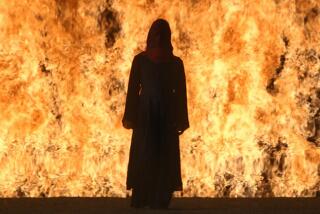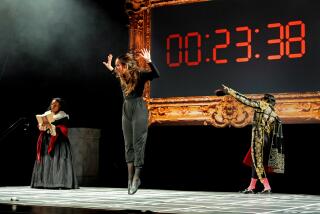Reich’s ‘The Cave’ Stands Revealed: It’s an Oratorio
- Share via
Steve Reich’s “The Cave,” which had its West Coast premiere Thursday night at the Irvine Barclay Theatre, looks like CNN. Made in collaboration with his wife, video artist Beryl Korot, “The Cave” is presented on five video screens, with the libretto and the music derived from documentary footage of talking heads.
Yet nothing could be further from what has demeaningly been called CNN opera--new works for the lyric stage based on current events--or, actually, any other kind of opera.
When “The Cave” had its premiere in Vienna four years ago, Reich claimed that it represented a radical, modern approach to the art form. Calling it a video opera, he and Korot fashioned three acts out of footage they shot from interviews with Israelis, Palestinians and Americans, about the story of Abraham.
They traveled to Israel to find out how Jews and Muslims viewed the origins of their people. They explored the differences between Genesis and the Koran. They went in search of the Cave of the Patriarchs, in the Arab town of Hebron, where Abraham and Sarah are said to be buried and the only place on earth where Jews and Muslims both worship.
Then they came back home to see what Americans thought of all this.
From this material, Reich has fashioned a fascinating and deeply affecting modern religious epic. There is an act for the Israelis, one for the Palestinians and one for the Americans. In each, fragments from the interviews are seen darting from monitor to monitor. The expert Steve Reich Ensemble, conducted by Paul Hillier, captures the rhythms of their speech and turns them into melody, while a quartet of singers retrieve these speech melodies and turn them into song.
So the story of Abraham is told in many voices and from many perspectives, with music as a kind of glue to hold together the mosaic. Visually the analogy to a mosaic also holds, since Korot’s main technique is to use two screens for the talking heads and the other screens for a magnified detail of the background, creating a kind of color and pattern setting for each subject.
The story is also typed out on screen--typing, too, is music, and one more example of Reich’s brilliance at transforming all the world around him into a exhilarating percussion music.
And yet, and yet. “The Cave” for all its technological dazzle--the complexities of synchronization are staggering--is not operatic theater. It contains strong music, which can be heard effectively on its own on a Nonesuch recording. But still half the experience is video, which makes for few possibilities for staging. The original production had musicians on various platforms and with some rudimentary movement, and ended up looking like a bargain-basement version of the famous spaceship scene from “Einstein on the Beach,” the opera by Robert Wilson and Reich’s nemesis, Philip Glass.
All those problems are now finally solved with a more modest production by Nick Mangano and lit with mystery by Matthew Frey. A simple set dominated by video screens and sparklingly clear projection treats the work like what it more truly is, a radical new kind of oratorio, not opera. And through the clarity and directness of this new approach, the real drama becomes clearly that not of Abraham but of the composer himself.
Much of the Israeli and Palestinian acts are slow going. It takes an obvious labor to translate Hebrew and Arabic accents into American pattern music. The speakers are articulate and passionate, the Cave is their home, and the issues lie close to the bone. (One of the powerful insights of “The Cave” is how it reveals the kinship in manner and speech and belief of the Israelis and Arabs.)
But the Americans are different, different from the Israelis and Arabs and different from each other. There are a few celebrities from religion and art world and science--Carl Sagan and Dennis Prager pop up. There are members of different races. Yet all of them have a kind of ardent speech that makes for a lively music. They are not so connected to the Bible but more to the world around them. They think not of absolute ancient truths but of modern applications of old wisdom.
And so “The Cave,” which started out as the composer’s search for his roots, becomes a celebration of his Americanism, using everything in technology currently available to represent our time and place. Oratorio may not be thought as sexy a medium a opera, but Reich has made it so, even if he insists on calling it opera.
* “The Cave,” tonight at 8, Sunday at 2:30 and 7:30 p.m., Irvine Barclay Theatre, 4242 Campus Drive, (714) 553-2422. $30-$38.
More to Read
The biggest entertainment stories
Get our big stories about Hollywood, film, television, music, arts, culture and more right in your inbox as soon as they publish.
You may occasionally receive promotional content from the Los Angeles Times.











